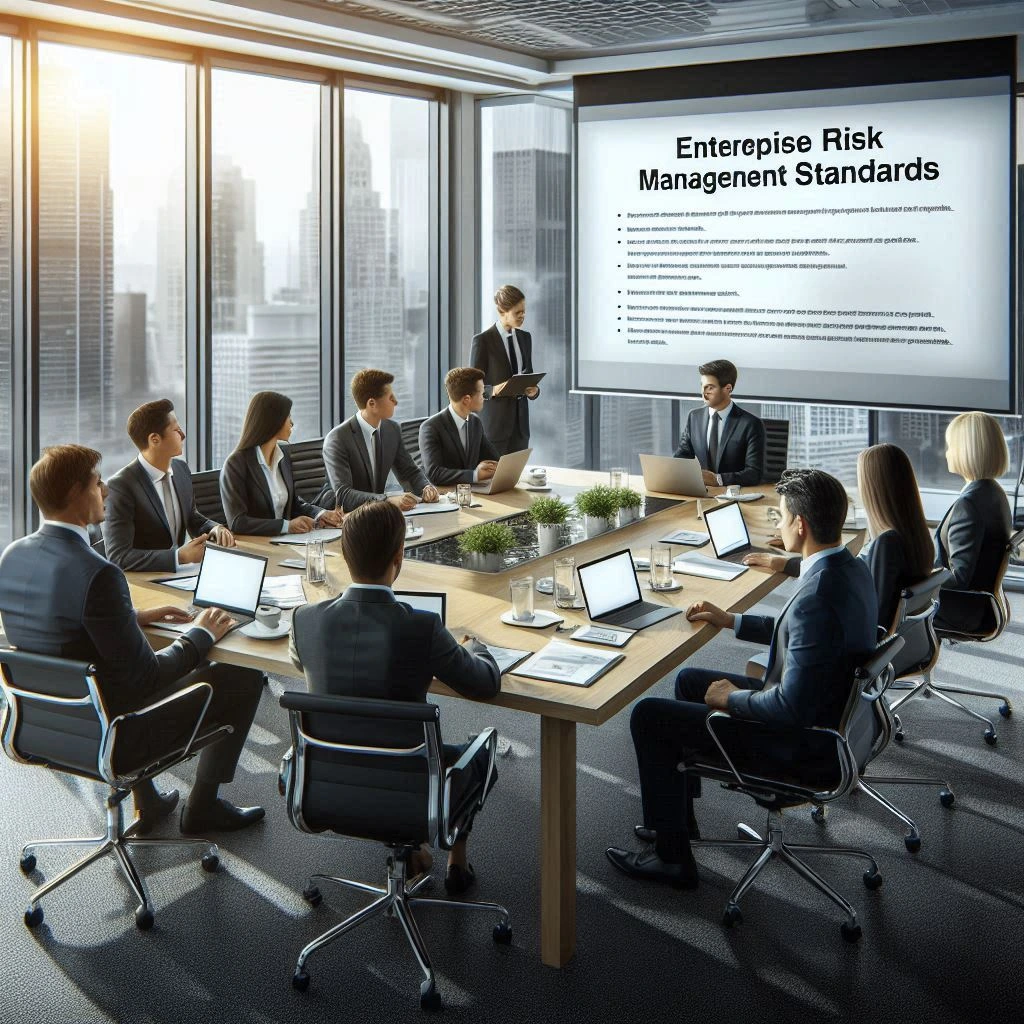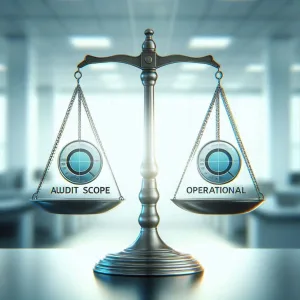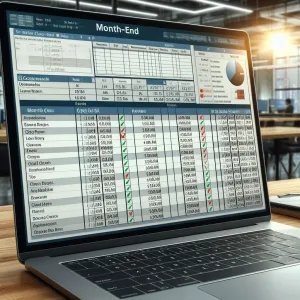Enterprise Risk Management (ERM) is a comprehensive framework that organizations utilize to identify, assess, and mitigate risks that could potentially hinder their ability to achieve strategic objectives. It encompasses a systematic approach to managing risks across the entire organization, particularly when integrating enterprise risk management with internal audit processes, rather than in silos, ensuring that all potential threats are considered in decision-making processes. This holistic view of risk management is essential in today’s dynamic business environment, where organizations face a multitude of risks ranging from operational to strategic and compliance-related challenges.
Definition of Enterprise Risk Management (ERM)
ERM can be defined as a structured, consistent, and continuous process for managing risks across an organization. It involves the identification of risks, assessment of their potential impact, and the implementation of strategies to mitigate those risks. The goal of ERM is not only to protect the organization from potential losses but also to enhance its ability to seize opportunities by making informed decisions based on a comprehensive understanding of risk exposure. This proactive approach to risk management is crucial for maintaining organizational resilience and ensuring long-term success in an increasingly complex and uncertain environment [4][9].
Overview of the Relationship Between ERM and Internal Audit
The relationship between ERM and internal audit is integral to the overall risk management framework of an organization. Internal auditors play a vital role in evaluating the effectiveness of ERM processes and ensuring that risk management practices align with the organization’s objectives. They provide assurance that the risk management framework is functioning effectively and that risks are being managed appropriately. This includes reviewing the management of key risks, evaluating the reporting of those risks, and assessing whether the established risk management processes contribute to achieving the organization’s goals [1][10].
Internal audit functions are increasingly expected to adopt a risk-based approach, which starts with an assessment of the organization’s top risks and business objectives. By aligning their audit plans with the organization’s risk profile, internal auditors can provide valuable insights and recommendations that enhance the effectiveness of ERM initiatives [11][12]. This collaboration between internal audit and ERM not only strengthens the organization’s risk management capabilities but also fosters a culture of risk awareness throughout the organization.
Importance of ERM in Enhancing Organizational Resilience and Decision-Making
Implementing an effective ERM framework is crucial for enhancing organizational resilience. By systematically identifying and managing risks, organizations can better prepare for uncertainties and adapt to changing circumstances. This resilience is particularly important in today’s fast-paced business landscape, where organizations must navigate various challenges, including economic fluctuations, regulatory changes, and technological advancements.
Moreover, ERM plays a significant role in improving decision-making processes within organizations. By providing a comprehensive view of risks and their potential impacts, ERM enables leaders to make informed decisions that align with the organization’s strategic objectives. This informed decision-making not only helps in mitigating risks but also in capitalizing on opportunities that may arise in the market [4][8]. Ultimately, a robust ERM framework empowers organizations to achieve their goals while maintaining a proactive stance towards risk management.
Understanding the principles of ERM and its relationship with internal audit is essential for internal audit professionals and compliance officers. By embracing ERM standards, they can enhance their effectiveness in safeguarding the organization’s assets and ensuring its long-term viability in an ever-evolving risk landscape.
Key ERM Standards and Frameworks
In the realm of enterprise risk management (ERM), internal auditors play a crucial role in ensuring that organizations effectively identify, assess, and manage risks. Understanding the key ERM standards and frameworks is essential for internal audit professionals and compliance officers. Below is an overview of the most significant ERM standards and frameworks that guide ERM practices.
COSO ERM Framework
- Overview: The Committee of Sponsoring Organizations of the Treadway Commission (COSO) developed the COSO ERM Framework, which provides a structured approach to risk management. It emphasizes the importance of integrating risk management into the organization’s overall governance and strategic planning processes.
- Components: The framework consists of several components, including:
- Governance and Culture: Establishing a risk-aware culture and governance structure.
- Strategy and Objective-Setting: Aligning risk management with the organization’s objectives.
- Performance: Evaluating how risks may affect the achievement of objectives.
- Review and Revision: Continuously improving risk management processes.
- Information, Communication, and Reporting: Ensuring relevant risk information is communicated effectively across the organization [5][10].
ISO 31000
- Principles and Guidelines: ISO 31000 is an international standard that provides principles and guidelines for risk management. It is designed to be applicable to any organization, regardless of size or industry.
- Key Principles:
- Integration: Risk management should be integrated into the organization’s governance structure and decision-making processes.
- Structured and Comprehensive: A structured approach ensures that risk management is comprehensive and consistent.
- Inclusive: Engaging stakeholders in the risk management process enhances understanding and ownership of risks.
- Dynamic: The risk management process should be adaptable to changes in the internal and external environment [4][10].
Other Relevant Standards
- Basel III: This framework is primarily aimed at banks and financial institutions, focusing on risk management related to capital adequacy, stress testing, and market liquidity risk. It emphasizes the need for robust risk management practices to enhance the stability of the financial system.
- ISO 9001: While primarily a quality management standard, ISO 9001 includes elements of risk management that can be beneficial for organizations looking to improve their overall risk management practices. It encourages organizations to identify risks that could impact the quality of their products and services, thereby supporting a proactive approach to risk management [6].
Understanding these key ERM standards and frameworks is vital for internal auditors and compliance officers. By aligning their practices with COSO ERM, ISO 31000, and other relevant standards, they can enhance their organization’s resilience against risks and contribute to effective governance and strategic decision-making. This knowledge not only aids in compliance but also fosters a culture of risk awareness throughout the organization, ultimately leading to better risk management outcomes.
The Role of Internal Audit in ERM
Internal auditors play a pivotal role in the Enterprise Risk Management (ERM) process, ensuring that organizations effectively identify, assess, and manage risks. Their contributions are essential for enhancing the overall risk management framework and aligning it with the organization’s strategic objectives. Here are the key points regarding the role of internal audit in ERM:
- Assessing the Effectiveness of the ERM Framework: Internal auditors are tasked with evaluating the effectiveness of the organization’s ERM framework. This involves reviewing the processes and controls in place to manage risks and ensuring they align with established ERM standards. By benchmarking the current state of risk management against maturity models, internal auditors can provide insights into areas for improvement and help organizations aspire to higher levels of risk management maturity [9][10].
- Identifying Risks and Opportunities: One of the core functions of internal audit is to identify both risks and opportunities within the organization. This includes performing detailed process reviews to pinpoint key risks and controls, as well as potential pain points and improvement opportunities. By documenting and analyzing the control environment, internal auditors can help organizations understand their risk landscape better and make informed strategic decisions [3][11][14].
- Providing Independent Assurance and Insights: Internal auditors offer independent assurance to management and the board regarding the effectiveness of the ERM processes. They validate the most significant risks that could impact the achievement of the organization’s strategic objectives and communicate these findings effectively. This independent perspective is crucial for fostering trust and ensuring that risk management practices are robust and aligned with the organization’s goals [6][12].
Internal auditors are integral to the ERM process, providing valuable assessments, identifying risks and opportunities, and delivering independent insights that enhance the organization’s risk management capabilities. Their role not only supports compliance but also contributes to the strategic decision-making process, ultimately leading to a more resilient organization.
Aligning Internal Audit with ERM Standards
In the realm of internal auditing, aligning practices with Enterprise Risk Management (ERM) standards is crucial for enhancing risk management effectiveness. This section will explore how internal audit professionals and compliance officers can adopt a risk-based approach, integrate ERM standards into their methodologies, and develop key performance indicators (KPIs) to measure the effectiveness of ERM initiatives.
Adopting a Risk-Based Approach in Internal Audit Planning
A risk-based approach is essential for internal audit planning as it allows auditors to focus on areas that pose the greatest risk to the organization. This involves:
- Identifying Key Risks: Internal auditors should work closely with ERM teams to identify and prioritize risks that could impact the organization’s objectives. This collaboration ensures that the audit plan addresses the most significant risks effectively [7].
- Resource Allocation: By understanding the risk landscape, auditors can allocate resources more efficiently, ensuring that high-risk areas receive the necessary attention during audits [5].
- Continuous Monitoring: A risk-based approach also facilitates ongoing monitoring of risks, allowing internal auditors to adapt their plans as new risks emerge or existing risks evolve [9].
Integrating ERM Standards into Audit Methodologies
Integrating ERM standards into internal audit methodologies enhances the overall effectiveness of risk management. This can be achieved through:
- Framework Alignment: Internal auditors should align their methodologies with established ERM frameworks, such as COSO or ISO 31000. This alignment ensures that audits are conducted in a manner that supports the organization’s risk management objectives [8].
- Collaboration with ERM Teams: Regular collaboration between internal audit and ERM teams fosters a shared understanding of risk management processes, leading to more comprehensive audits that consider both compliance and operational risks [9].
- Training and Development: Providing training for internal auditors on ERM standards and practices can enhance their ability to assess risks effectively and contribute to the organization’s risk management efforts [3].
Developing Key Performance Indicators (KPIs) for Measuring ERM Effectiveness
To assess the effectiveness of ERM initiatives, internal auditors should develop and monitor KPIs that provide insights into risk management performance. Key considerations include:
- Defining Relevant KPIs: KPIs should be tailored to the organization’s specific risk profile and objectives. Common KPIs might include the number of identified risks, the effectiveness of risk mitigation strategies, and the timeliness of risk reporting [6].
- Regular Review and Adjustment: KPIs should be reviewed regularly to ensure they remain relevant and aligned with the organization’s evolving risk landscape. This ongoing assessment allows for adjustments to be made in response to changes in the business environment [10].
- Reporting and Communication: Effective communication of KPI results to stakeholders, including the Board of Directors, is essential for fostering a culture of risk awareness and accountability within the organization [9].
Aligning internal audit practices with ERM standards is vital for effective risk management. By adopting a risk-based approach, integrating ERM standards into audit methodologies, and developing relevant KPIs, internal auditors can significantly enhance their contribution to the organization’s overall risk management framework. This alignment not only supports compliance but also promotes operational efficiency and financial integrity, ultimately benefiting the organization as a whole.
Challenges Internal Auditors Face in ERM Implementation
Implementing Enterprise Risk Management (ERM) within organizations presents several challenges for internal auditors. Understanding these barriers is crucial for internal audit professionals and compliance officers aiming to enhance their effectiveness in risk management. Here are some of the key challenges:
- Resistance to Change Within the Organization: One of the most significant hurdles is the inherent resistance to change that often exists within organizations. Employees and management may be accustomed to existing processes and may view the introduction of ERM as an unnecessary disruption. This resistance can hinder the adoption of new risk management practices and limit the effectiveness of internal audits in identifying and mitigating risks [3].
- Lack of Clear Communication and Understanding of ERM Roles: Effective ERM implementation requires a clear understanding of roles and responsibilities among all stakeholders, including internal auditors. However, a common challenge is the lack of clear communication regarding these roles. When internal auditors are not fully aware of their responsibilities in the ERM framework, it can lead to confusion and inefficiencies in risk assessment and management processes [10]. This lack of clarity can also result in internal auditors inadvertently overstepping their boundaries, which may undermine management’s decision-making authority [6].
- Resource Limitations and Skills Gaps in the Audit Function: Internal audit functions often face resource constraints, including limited personnel and budgetary restrictions. These limitations can impede the ability of internal auditors to effectively engage in ERM activities. Additionally, there may be skills gaps within the audit team, particularly in understanding complex risk management frameworks and methodologies. This can hinder the internal audit’s ability to provide valuable insights and assurance regarding the organization’s risk management practices [15].
Addressing these challenges is essential for internal auditors to effectively integrate ERM into their audit processes. By fostering a culture of openness to change, enhancing communication about roles, and investing in the development of skills and resources, organizations can improve their ERM implementation and strengthen the overall internal audit function.
Best Practices for Internal Auditors in ERM
Enterprise Risk Management (ERM) is a critical framework that internal auditors must understand to effectively assess and enhance an organization’s risk management processes. Here are some actionable recommendations for internal auditors to strengthen their engagement in ERM:
- Continuous Professional Development on ERM Standards: Internal auditors should prioritize ongoing education regarding ERM standards. This includes familiarizing themselves with the eight components of ERM, which encompass the internal environment, objective setting, event identification, risk assessment, and more. By staying updated on the latest ERM frameworks and best practices, auditors can better evaluate the effectiveness of risk management strategies within their organizations [5][6].
- Building Collaborative Relationships with Risk Management Teams: Establishing strong partnerships with risk management professionals is essential. Internal auditors should engage with these teams to gain insights into the organization’s risk landscape and to align audit activities with the organization’s risk priorities. This collaboration can lead to a more comprehensive understanding of risks and enhance the overall effectiveness of both auditing and risk management efforts [8].
- Utilizing Technology and Data Analytics for Risk Assessment: Leveraging technology and data analytics is crucial for modern internal auditing. By employing advanced analytical tools, auditors can identify patterns and anomalies in risk data, which can lead to more informed decision-making. This approach not only improves the efficiency of risk assessments but also enhances the ability to spot potential issues before they escalate [7].
By implementing these best practices, internal auditors can significantly contribute to the effectiveness of ERM within their organizations, ensuring that risks are managed proactively and strategically.
Conclusion
In the realm of internal auditing, the integration of Enterprise Risk Management (ERM) standards is not just beneficial; it is essential for ensuring that organizations effectively identify, assess, and mitigate risks. Internal auditors play a critical role in this process by providing assurance that significant risks are appropriately managed and that the organization’s risk management framework is robust and responsive to changing conditions.
Key takeaways include:
- Critical Role of Internal Auditors: Internal auditors are pivotal in evaluating the effectiveness of ERM processes. They assess whether significant risks are identified and managed continuously, thereby enhancing the organization’s overall risk profile and resilience [1][5]. Their insights contribute to a more comprehensive understanding of risk exposure and help in aligning risk management with business objectives [2][4].
- Embracing ERM Standards: By adopting ERM standards, internal auditors can improve audit outcomes significantly. These standards provide a structured approach to risk management, enabling auditors to focus their resources on the most critical areas of risk [3][9]. This alignment not only enhances the quality of audits but also fosters a culture of risk awareness throughout the organization.
- Ongoing Learning and Adaptation: The risk landscape is constantly evolving, influenced by factors such as technological advancements, regulatory changes, and market dynamics. Internal auditors must commit to ongoing learning and adaptation to stay ahead of emerging risks [6][10]. This proactive approach ensures that audit practices remain relevant and effective in addressing new challenges.
In summary, the integration of ERM standards into internal auditing practices is vital for fostering a resilient organizational framework. By recognizing their critical role, embracing established standards, and committing to continuous learning, internal auditors can significantly enhance their contributions to effective risk management and organizational success.
Find out more about Shaun Stoltz https://www.shaunstoltz.com/about/
This post was written by an AI and reviewed/edited by a human.



